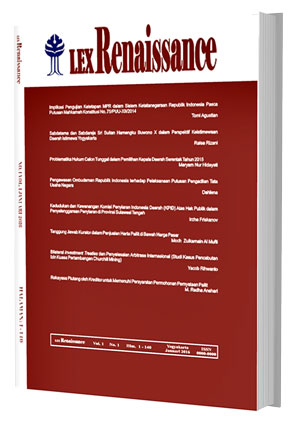Main Article Content
Abstract
This study discusses the use of indicative evidence as a basis for proving adultery and what kind of indicative evidence has the justification for proving adultery. The research method used is normative juridical with a case and statutory approach. The results of the study concluded that: First, the use of indicative evidence is very much dominated by the subjectivity of judges. This evidence is used after the judge is absolutely sure that the defendant has committed adultery based on the conformity and logical relationship between each fact and the element of adultery that is to be proven. When using indicative evidence, the judge strongly emphasized the fact that the defendant was together in a closed room within a period of time that allowed for adultery, to be linked to the Supreme Court Decision Number 854K / Pid / 1983, which became the legal source of proof of adultery or sexual intercourse. The use of indicative evidence is always linked to the inability of the defendant to prove his argument; and Second, indicative evidence that has justification must meet the formal and material requirements.
Keywords
Article Details
Authors who publish with this journal agree to the following terms:
a. Authors retain copyright and grant the journal right of first publication with the work simultaneously licensed under a Creative Commons Attribution License that allows others to share the work with an acknowledgement of the work's authorship and initial publication in this journal.
b. Authors are able to enter into separate, additional contractual arrangements for the non-exclusive distribution of the journal's published version of the work (e.g., post it to an institutional repository or publish it in a book), with an acknowledgement of its initial publication in this journal.
c. Authors are permitted and encouraged to post their work online (e.g., in institutional repositories or on their website) prior to and during the submission process, as it can lead to productive exchanges, as well as earlier and greater citation of published work (See The Effect of Open Access).References
- Buku
- Alfitra. Hukum Pembuktian dalam Beracara Pidana, Perdata dan Korupsi di Indonesia, Raih Asa Sukses, Jakarta, 2017.
- Chazawi, Adami. Hukum Pembuktian Tindak Pidana Korupsi, Media Nusa Creative, Malang, 2018.
- Fuady, Munir. Teori Hukum Pembuktian Pidana dan Perdata, Citra Aditya Bakti, Bandung, 2020.
- Hamzah, Andi. Hukum Acara Pidana, Sinar Grafika, Jakarta, 2013.
- _______, Delik-Delik Tertentu (Speciale Delicten) Di Dalam KUHP, Sinar Grafika, Jakarta, 2017.
- Harahap, Yahya. Pembahasan Permasalahan dan Penerapan KUHAP: Pemeriksaan Sidang Pengadilan, Banding, Kasasi dan Peninjauan Kembali, Sinar Grafika, Jakarta, 2015.
- Hiariej, Eddy O.S. Teori dan Hukum Pembuktian, Erlangga, Jakarta, 2012.
- Lamintang, P.A.F. Pembahasan KUHAP Menurut Ilmu Pengetahuan Hukum Pidana dan Yurisprudensi, Sinar Grafika, Jakarta, 2010.
- Marzuki, Peter Mahmud. Penelitian Hukum, Prenada Media, Jakarta, 2011.
- Soerodibroto, R. Soenarto. KUHP DAN KUHAP Dilengkapi Yurisprudensi Mahkamah Agung dan Hoge Raad, RajaGrafindo Persada, Jakarta, 2006.
- Soesilo, R. Kitab Undang-Undang Hukum Pidana (KUHP) Serta Komentar-Komentarnya Lengkap Pasal Demi Pasal, Politeia, Bogor, 1995.
- Sugandhi R. Kitab Undang-Undang Hukum Pidana dan Penjelasannya, Usaha Nasional, Surabaya, 1981.
- Peraturan Perundang-Undangan
- Undang-Undang Nomor 8 Tahun 1981 Tentang Hukum Acara Pidana, Lembaran Negara Republik Indonesia Nomor 76 Tahun 1981, Tambahan Lembaran Negara Nomor 3209.
References
Buku
Alfitra. Hukum Pembuktian dalam Beracara Pidana, Perdata dan Korupsi di Indonesia, Raih Asa Sukses, Jakarta, 2017.
Chazawi, Adami. Hukum Pembuktian Tindak Pidana Korupsi, Media Nusa Creative, Malang, 2018.
Fuady, Munir. Teori Hukum Pembuktian Pidana dan Perdata, Citra Aditya Bakti, Bandung, 2020.
Hamzah, Andi. Hukum Acara Pidana, Sinar Grafika, Jakarta, 2013.
_______, Delik-Delik Tertentu (Speciale Delicten) Di Dalam KUHP, Sinar Grafika, Jakarta, 2017.
Harahap, Yahya. Pembahasan Permasalahan dan Penerapan KUHAP: Pemeriksaan Sidang Pengadilan, Banding, Kasasi dan Peninjauan Kembali, Sinar Grafika, Jakarta, 2015.
Hiariej, Eddy O.S. Teori dan Hukum Pembuktian, Erlangga, Jakarta, 2012.
Lamintang, P.A.F. Pembahasan KUHAP Menurut Ilmu Pengetahuan Hukum Pidana dan Yurisprudensi, Sinar Grafika, Jakarta, 2010.
Marzuki, Peter Mahmud. Penelitian Hukum, Prenada Media, Jakarta, 2011.
Soerodibroto, R. Soenarto. KUHP DAN KUHAP Dilengkapi Yurisprudensi Mahkamah Agung dan Hoge Raad, RajaGrafindo Persada, Jakarta, 2006.
Soesilo, R. Kitab Undang-Undang Hukum Pidana (KUHP) Serta Komentar-Komentarnya Lengkap Pasal Demi Pasal, Politeia, Bogor, 1995.
Sugandhi R. Kitab Undang-Undang Hukum Pidana dan Penjelasannya, Usaha Nasional, Surabaya, 1981.
Peraturan Perundang-Undangan
Undang-Undang Nomor 8 Tahun 1981 Tentang Hukum Acara Pidana, Lembaran Negara Republik Indonesia Nomor 76 Tahun 1981, Tambahan Lembaran Negara Nomor 3209.




